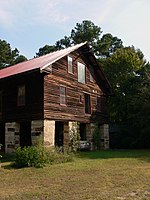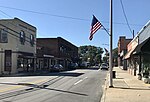Shotwell, North Carolina
Unincorporated communities in North CarolinaUnincorporated communities in Wake County, North CarolinaUse mdy dates from July 2023Wake County, North Carolina geography stubs

Shotwell is an unincorporated community in rural eastern Wake County, North Carolina, United States, located about 4 miles (6.4 km) south of Knightdale and 11 miles (18 km) east of Raleigh at the confluence of Smithfield, Mial Plantation, Major Slade, Grasshopper, and Turnipseed Roads. Shotwell has been inhabited since the early 19th century and is home to a number of historic structures. A post office was established in 1883 but closed less than two decades later.Oaky Grove was listed on the National Register of Historic Places in 1993.
Excerpt from the Wikipedia article Shotwell, North Carolina (License: CC BY-SA 3.0, Authors, Images).Shotwell, North Carolina
Major Slade Road,
Geographical coordinates (GPS) Address Nearby Places Show on map
Geographical coordinates (GPS)
| Latitude | Longitude |
|---|---|
| N 35.737222222222 ° | E -78.444722222222 ° |
Address
Major Slade Road
Major Slade Road
North Carolina, United States
Open on Google Maps





